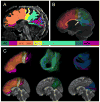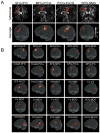Atlas-guided tract reconstruction for automated and comprehensive examination of the white matter anatomy
- PMID: 20570617
- PMCID: PMC2910162
- DOI: 10.1016/j.neuroimage.2010.05.049
Atlas-guided tract reconstruction for automated and comprehensive examination of the white matter anatomy
Abstract
Tractography based on diffusion tensor imaging (DTI) is widely used to quantitatively analyze the status of the white matter anatomy in a tract-specific manner in many types of diseases. This approach, however, involves subjective judgment in the tract-editing process to extract only the tracts of interest. This process, usually performed by manual delineation of regions of interest, is also time-consuming, and certain tracts, especially the short cortico-cortical association fibers, are difficult to reconstruct. In this paper, we propose an automated approach for reconstruction of a large number of white matter tracts. In this approach, existing anatomical knowledge about tract trajectories (called the Template ROI Set or TRS) were stored in our DTI-based brain atlas with 130 three-dimensional anatomical segmentations, which were warped non-linearly to individual DTI data. We examined the degree of matching with manual results for selected fibers. We established 30 TRSs to reconstruct 30 prominent and previously well-described fibers. In addition, TRSs were developed to delineate 29 short association fibers that were found in all normal subjects examined in this paper (N=20). Probabilistic maps of the 59 tract trajectories were created from the normal subjects and were incorporated into our image analysis tool for automated tract-specific quantification.
Copyright 2010 Elsevier Inc. All rights reserved.
Conflict of interest statement
The terms of this arrangement are being managed by the Johns Hopkins University in accordance with its conflict of interest policies.
Figures






References
-
- Alexander DC, Pierpaoli C, Basser PJ, Gee JC. Spatial transformations of diffusion tensor magnetic resonance images. IEEE Trans Med Imaging. 2001;20:1131–1139. - PubMed
-
- Ashburner J, Friston KJ. Voxel-based morphometry--the methods. Neuroimage. 2000;11:805–821. - PubMed
-
- Basser PJ, Mattiello J, LeBihan D. Estimation of the effective self-diffusion tensor from the NMR spin echo. J Magn Reson B. 1994;103:247–254. - PubMed
-
- Basser PJ, Pajevic S, Pierpaoli C, Duda J, Aldroubi A. In vitro fiber tractography using DT-MRI data. Magn Reson Med. 2000;44:625–632. - PubMed
-
- Behrens TE, Johansen-Berg H, Woolrich MW, Smith SM, Wheeler-Kingshott CA, Boulby PA, Barker GJ, Sillery EL, Sheehan K, Ciccarelli O, Thompson AJ, Brady JM, Matthews PM. Non-invasive mapping of connections between human thalamus and cortex using diffusion imaging. Nat Neurosci. 2003;6:750–757. - PubMed
Publication types
MeSH terms
Grants and funding
- R01 AG020012/AG/NIA NIH HHS/United States
- R21AG033774/AG/NIA NIH HHS/United States
- R01 NS058299/NS/NINDS NIH HHS/United States
- P01EB001955/EB/NIBIB NIH HHS/United States
- R01 EB000975/EB/NIBIB NIH HHS/United States
- R21 AG033774/AG/NIA NIH HHS/United States
- P50 AG005146/AG/NIA NIH HHS/United States
- P01 EB001955/EB/NIBIB NIH HHS/United States
- R01AG20012/AG/NIA NIH HHS/United States
- P41 RR015241/RR/NCRR NIH HHS/United States
- P50AG05146/AG/NIA NIH HHS/United States
- R01 HD065955/HD/NICHD NIH HHS/United States
- P41 EB015909/EB/NIBIB NIH HHS/United States
LinkOut - more resources
Full Text Sources
Other Literature Sources

